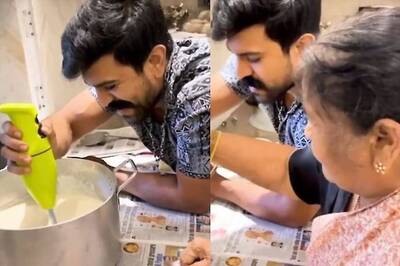
views
Hailing the passage of the historic OBC Bill in the monsoon session of the Parliament in 2021, Prime Minister Narendra Modi said that it underscored his government’s commitment to ensuring dignity, opportunity and justice to the marginalised sections. “Passage of the Constitution (127th Amendment) Bill, 2021 in both Houses is a landmark moment for our nation. This Bill furthers social empowerment. It also reflects our government’s commitment to ensuring dignity, opportunity and justice to the marginalised sections,” the PM had said, in a post.
The power of States and Union Territories to make their own OBC lists for the purpose of reservation in jobs and educational institutes was rightfully restored by the Modi government. Once the Bill became an Act, it helped and empowered 671 communities, that in effect amounted to about one-fifth of the total OBCs in the country, as per reports. Basically, the 127th Amendment Bill sought to restore powers to States to notify backward classes, bypassing an earlier May 5, 2021 verdict of the Supreme Court which allowed only the Centre to notify socially and educationally backward classes (SEBCs).
What was the Supreme Court’s May 5, 2021 verdict?
In a categorical verdict while hearing the Maratha quota issue, the Supreme Court, on May 5, 2021, upheld the 102nd Constitutional Amendment, saying that the President, based on the recommendations of the National Commission for Backward Classes (NCBC), would determine which communities would be included on the State OBC list. The 102nd Amendment Act raised the issue of the single Central list of SEBCs taking away the powers of the States to prepare their own list of OBCs. The Supreme Court, in its categorical ruling on May 5, also directed that following the amendment, States will not have the power to identify SEBCs separately from the Centre. The government filed a review petition challenging the top court’s order, which was dismissed. Eventually, the Centre came up with the 127th Amendment bill to undo the Supreme Court’s ruling.
What is the 102nd Constitutional Amendment?
The 102nd Constitution Amendment Act inserted three new Articles, namely, 342A, 366 (26C) and 338B in the Constitution. Of these, 338B dealt with the structure, duties and powers of the National Commission for Backward Classes, and 342A dealt with the powers of the President of India to notify a particular caste as Socially and Educationally Backward Communities (SEBCs) and the power of Parliament to change the list. Article 366 (26C) defined SEBCs.
“In the task of identification of SEBCs, the President shall be guided by the Commission set up under Article 338B; its advice shall also be sought by the State in regard to policies that might be framed by it. If the commission prepares a report concerning matters of identification, such a report has to be shared with the State government, which is bound to deal with it, in accordance with provisions of Article 338B. However, the final determination culminates in the exercise undertaken by the President (i.e. the Central Government, under Article 342A (1), by reason of Article 367 read with Section 3 (8) (b) General Clauses Act),” the Apex Court judgement of May 5, 2021, upholding the 102nd Amendment, had said.
“The States’ power to make reservations, in favour of particular communities or castes, the quantum of reservations, the nature of benefits and the kind of reservations, and all other matters falling within the ambit of Articles 15 and 16 – except with respect to identification of SEBCs, remains undisturbed,” the judgement had further said.
What was the 127th Amendment Bill?
Following the amendment in Articles 366 (26C) and 338B (9), States were/are now able to directly notify OBCs, and SEBCs without having to refer to the NCBC and the OBC lists prepared by States will be taken out of the domain of the President, and can be notified by the Assemblies of concerned States. Nearly 671 OBC communities would have lost access to reservations in educational institutions and appointments if the State lists had been abolished, as per the 102nd Amendment.
The 127th Amendment, however, restored power to the States, superseding the 102nd Amendment, thereby displaying, among other things, PM Modi’s commitment to cooperative federalism. “The legislative intent at the time of passing of the Constitution (102nd Amendment) Act, 2018 was that it deals with the Central list of the SEBCs. It recognises the fact that even before the declaration of the Central list of SEBCs in 1993, many States/Union Territories are having their own State List/Union territory List of OBCs,” the statement in the 127th Amendment Bill noted.
The Congress party, which was in government for the longest time at the Centre, never cared for the OBCs. The absolutely shoddy treatment meted out to the Kaka Kalelkar Commission by the then PM Jawaharlal Nehru, was repeated with the B.P. Mandal Commission by Indira Gandhi and Rajiv Gandhi. Adhering to Article 340 of the Constitution of India, the First Backward Classes Commission was set up by a Presidential order on January 29, 1953, under the Chairmanship of Kaka Kalelkar. Nehru, however, unceremoniously threw the Kalelkar committee proposals in the bin. The BJP-supported V.P. Singh government at the Centre implemented the Mandal Commission, which was opposed tooth and nail by Rajiv Gandhi, both inside and outside the Parliament. It is obvious and unfortunate to note that whenever the Congress came to power, the party’s biased and anti-OBC psyche prevented it from strengthening the OBC community.
From the political victimisation of Babasaheb Ambedkar, Syama Prasad Mukherjee, Ram Manohar Lohia, Jayaprakash Narayan, B.P. Mandal, Karpoori Thakur, K. Kamaraj, Devaraj Urs to V.P. Singh, Arjun Singh, Sitaram Kesri and Rajesh Pilot, the Congress party has an unenviable track record. In fact, an anti-reservation Congress was always opposed to the idea of giving reservations to either SC/STs or OBCs in the all-India quota (AIQ) for medical seats. AIQ in medical seats was introduced in 1986 only on the instructions of the Supreme Court of India and not due to Rajiv Gandhi, as the Congress would love to believe.
It is the Narendra Modi-led government which gave constitutional status to the National Commission of Backward Classes (NCBC) in 2018, after almost three decades of the Mandal Commission implementation. The inclusion of 12 SCs, 8 STs and 27 OBC ministers in the Cabinet reshuffle in July 2021 speaks volumes about the Modi government’s commitment to OBCs. At 37 per cent, OBC representation in the Modi cabinet today is the highest ever in post-independent India.
There have been demands for creating categories within OBCs to ensure equitable distribution of the quota benefit to all. Some states such as Bihar have experimented with the sub-categorisation and carved the reservation for extremely backward classes within the OBC reservation. In October 2017, the Centre constituted the Rohini Commission to examine the sub-categorisation and submit a report within 12 weeks.
What has the Draft Rohini Commission recommended?
It said, around 2633 castes are covered under the OBC reservation. The states have the flexibility to add castes to the Central list, depending on local deprivation levels determined by local OBC commissions. In February 2021, the Commission proposed to divide the 27 per cent reservation for the castes on the Central list into four sub-categories. While some have welcomed the sub-categorisation, experts believe the idea would be a meaningless exercise and could potentially polarise the society along caste lines. Experts believe that sharing the caste data could create more divide in society and lead to renewed demands for reducing the quota for certain castes and increasing it for others. There is also a fear that a repeat of the 1911 caste census could happen when the so-called upper castes were declared a social minority.
The 1931 census — the last caste-based census — was conducted primarily to identify the ways through which a colonial power could strengthen its stranglehold. The data was used to create a separate vote-bank in the 1980s, by leaders who emerged from Jai Prakash Narayan’s anti-corruption movement and led to the creation of Janata Dal. Experts believe something similar is being attempted now through the sub-categorisation of the OBC quota. Some Opposition parties know that a new caste census can help them create a new vote-bank of socially and economically deprived sections among the OBCs. At this stage, many experts believe that the social costs of a caste census far outweigh the benefits and it may not be a great idea. States already have enough information at their disposal which they can use to give targeted benefits of government schemes, including reservations, to deprived groups. The need for a caste census, therefore, at this stage, stands mitigated to that extent.
It is the Modi government which took the bold decision of a 27 per cent reservation for OBCs and 10 per cent for economically weaker sections (EWS) in various medical courses including MBBS, MD, MS, BDS, MDS and diplomas, two years back. This showcases PM Modi’s commitment to Sabka Saath, Sabka Vikas, Sabka Vishwas and Sabka Prayas, in more ways than one.
Do note that there was no reservation in the AIQ scheme until the Supreme Court intervened and introduced a reservation of 15 per cent for SCs and 7.5 per cent for STs in 2007. When the Central Educational Institutions (Reservation in Admission) Act became effective in 2007, providing for uniform 27 per cent reservation to OBCs, the same was implemented in all the Central Educational Institutions viz. Safdarjung Hospital, Lady Hardinge Medical College, Aligarh Muslim University and Banaras Hindu University etc. However, this was not extended to the AIQ seats of state medical and dental colleges. However, that is now possible.
According to the Health Ministry, nearly 1,500 OBC students in MBBS and 2,500 OBC students in post-graduation and around 550 EWS students in MBBS and around 1,000 EWS students in post-graduation, benefit from the Modi government’s historic decision every year. The reservation was announced under the AIQ scheme. The AIQ scheme was introduced in 1986 under the directions of the Supreme Court to provide for domicile-free merit-based opportunities to students from any state who aspire to study in a good medical college located in another state. All India Quota consists of 15 per cent of the total available UG seats and 50 per cent of the total available PG seats in government medical colleges.
A moot point to be noted here is that, for decades, political parties like the SP and BSP simply paid lip service to the cause of OBCs, who form a dominant 43-45 per cent of the total population in Uttar Pradesh. OBC sub-groups, whether it is non Yadavs, Kurmis, Koeris or others, were repeatedly let down by the likes of Akhilesh Yadav and Mayawati. However, the BJP’s acceptance among these “other non-Yadav OBCs” rose three-and-a-half times between 2012 and 2014 (from 17 to 60 per cent). This number is crucial as “other non-Yadav OBCs” constitute over 25 per cent of UP’s total population. In the 2014 Lok Sabha elections, one-fourth of the BJP’s total votes came from this section alone. These numbers have only improved in subsequent elections.
Importantly, while the SP only focused on the Yadavs, the BJP focused on both Yadav and non-Yadav OBCs without discriminating between the two and it is this politics of inclusivity that helped the BJP to become the dominant political force in UP, which till 2014, had always been driven by a Yadav-centric caste matrix.
During the last nine years, thanks to Prime Minister Modi’s focus on science, education, medicine and innovation, MBBS seats in the country have increased manifold, with the number up by 56 per cent from 54348 seats in 2014 to 84649 seats by 2020. The number of PG seats increased by 80 per cent from 30191 seats in 2014 to 54275 seats in 2020. During the same period, 179 new medical colleges were established and now, India boasts of well over 558 medical colleges, including over 289 government and over 269 private colleges.
It would be apt to conclude by saying that while successive Congress regimes only paid lip service to the cause of OBCs and the marginalised, it is the Modi government which finally brought to fruition various reforms to ensure that the benefits of inclusivity and development are made accessible to one and all, cutting through swathes of divisive rhetoric.
Speaking of OBC secretaries in the GoI, an ignorant Rahul Gandhi needs to know that the cutoff limit for empanelment of GoI secretaries was 1992, while most current secretaries are those inducted/hired prior to 1992. In fact, demarcation if any, of secretaries into OBCs, SCs, and STs happened only in 1995-96 and that is precisely why there are very few OBCs in secretarial posts within the GoI currently.
From lending his support and putting his personal capital at stake in ensuring Droupadi Murmu becomes the first tribal woman to become India’s President, to ensuring 37 per cent of his Cabinet members are OBCs, 11 SCs and 8 STs, PM Modi has done more for OBCs, Dalits and Adivasis than any of his predecessors. At 85 MPs, the BJP has more MPs in the Lok Sabha who are OBCs than the total number of MPs that the Congress has in the Lower House. Remember, the Congress only has 52 MPs in the Lok Sabha. Again 27 per cent of BJP’s MLAs and 40 per cent of MLCs are OBCs; the 1st OBC Prime Minister of India, the enigmatic Narendra Modi, is also from the BJP. Hence, the BJP certainly does not need any lessons or lectures on the empowerment of OBCs from the likes of an incompetent dynast like Rahul Gandhi or from the irrelevant leftist cabal that has been reduced to nothingness.
Speaking at the first Arun Jaitley Memorial lecture in July 2022, Prime Minister Modi questioned the audience—“I want to ask this question to all of you. Is real growth possible without inclusion? Can inclusion be thought of without growth?”
“Our diversity is not something that is on paper. It is the manifestation of our strength. It is not only our identity but also our tradition” is yet another powerful quote by PM Modi.
To cut to the chase, while Prime Minister Modi has always focused on inclusion and unity in diversity as his guiding mantras, the Opposition is running helter-skelter, peddling divisive narratives. The truth is, PM Modi has done more for OBCs and other marginalised groups than any of his predecessors and no amount of falsehoods by jaded dynasts from the Opposition can ever change that.
Sanju Verma is an Economist, National Spokesperson of the BJP and the Bestselling Author of ‘The Modi Gambit’. Views expressed in the above piece are personal and solely that of the author. They do not necessarily reflect News18’s views.




















Comments
0 comment